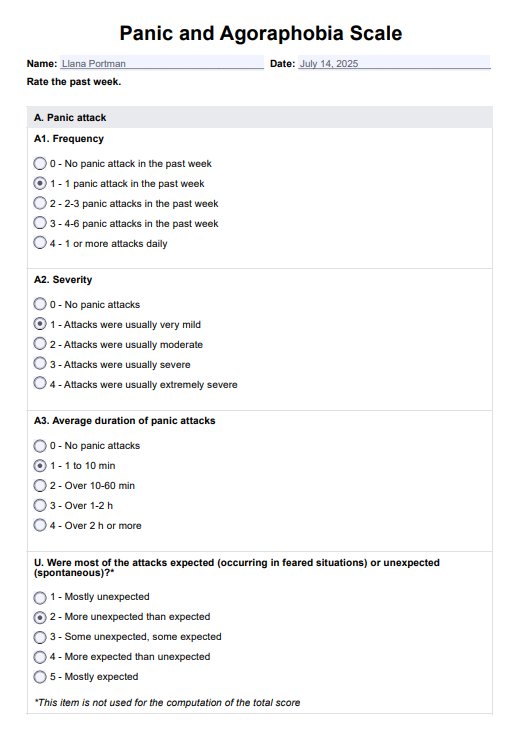Panic and Agoraphobia Scale
Learn about the Panic and Agoraphobia Scale (P&A). Access a free PDF template to assess your patient's level of panic and agoraphobia.


What is the Panic and Agoraphobia Scale?
The Panic and Agoraphobia Scale (P&A) is an essential tool for assessing panic disorder and agoraphobia (PDA). It measures the severity of these disorders following a diagnosis based on the Diagnostic and Statistical Manual of Mental Disorders (DSM) or the ICD-10.
Developed specifically for use in clinical trials in 1995 by Borwin Bandelow, this scale features 13 items assessed on a 5-point scale ranging from 0 to 4.
The scale has five subscales:
- A: Panic attacks
- B: Phobia avoidance
- C: Anticipatory anxiety
- D: Disability
- E: Worries about health
An additional item (U) is included to assess whether the attacks were anticipated or unforeseen. However, this item is not utilized in calculating the total score.
The inter-rater reliability, which serves as a measure of objectivity, was found to be 0.78 (p<0.005). Additionally, it has a Cronbach's alpha coefficient of 0.88 for self-rating (Bandelow, 1995).
Panic and Agoraphobia Scale Template
Panic and Agoraphobia Scale Example
How to use our Panic and Agoraphobia Scale template
Carepatron's Panic and Agoraphobia Scale template is a convenient tool for assessing the severity of panic disorder and agoraphobia. It can be used by healthcare professionals, researchers, or individuals themselves to track their symptoms over time. Here's how to utilize the template:
Step 1: Access the P&A
Click the "Use Template" button to access the Panic and Agoraphobia Scale via the Carepatron app. For a PDF copy, click "Download".
Step 2: Explain how it works
Give your patient a copy and explain how the scale works. Inform them that they should rate each item based on their experiences over the past 7 days.
Step 3: Rate items
Ask your patient to rate each of the 13 items on a scale from 0-4, with 0 being "not at all" and 4 being "extremely". Remind them not to omit any answers and to answer honestly.
Step 4: Calculate the total score
To calculate the total score, sum the individual scores from each subscale (A-E), with a maximum possible score of 52. Please note that item U is excluded from the total score calculation. Additionally, you can derive a subscore for each section by adding the relevant items and dividing the sum by the number of items in that section.
Step 5: Interpret the results
A higher total score may indicate a greater severity of panic disorder and agoraphobia. Consider the results in conjunction with other clinical information about the patient to determine the appropriate treatment plan.
When to use the Panic and Agoraphobia Scale
As mentioned, Bandelow (1995) developed the scale specifically for clinical trials. However, the P&A scale can also be used in other settings such as:
Routine evaluation of panic disorder and agoraphobia symptoms
The P&A scale can be used as a routine screening tool for individuals who are at risk of panic disorder and agoraphobia, such as those with a family history or previous diagnosis for PDA.
Monitoring treatment progress
The scale is aof useful in monitoring the effectiveness of treatment plans. By regularly administering the P&A scale, healthcare professionals can track changes in symptom severity over time and adjust treatment accordingly. This can also provide valuable information to researchers studying the efficacy of different treatments for panic disorder and agoraphobia.
Comparing results across different populations or settings
Using a standardized scale like P&A allows for easier comparison of results across different populations or settings. This can provide valuable insights into how panic disorder and agoraphobia may manifest differently in various groups and inform future research and interventions.
Benefits of free Panic and Agoraphobia Scale template
Our free P&A scale template allows for easy administration and scoring, making it a convenient tool for clinicians and researchers alike. Here are other advantages of our printable P&A template:
Fully digital
Our template is available in a digital format, which can be easily accessed and shared electronically. This eliminates the need for printing and scanning, saving time and resources.
User-friendly
Our template has a simple layout that's easy to navigate and understand. This makes it suitable for use by both clinicians and patients without much training or experience with the scale.
Customizable
Our template can be customized to fit the specific needs of your practice or research. You can add fields for demographics, treatment progress, or any other relevant information.
Reference
Bandelow, B. (1995). Assessing the efficacy of treatments for panic disorder and agoraphobia. II. The Panic and Agoraphobia Scale. International Clinical Psychopharmacology, 10(2), 73–82. https://doi.org/10.1097/00004850-199506000-00003
Commonly asked questions
The Panic and Agoraphobia Scale (P&A) is a tool used to assess the severity of panic attacks and agoraphobia. It measures symptoms related to anxiety disorders, including the frequency and intensity of panic attacks, avoidance behaviors, and overall functional impairment. A P&A score is the total score obtained from administering the scale, with higher scores indicating a greater severity of symptoms.
Agoraphobia is commonly measured through clinical interviews, self-report questionnaires, and scales like the Panic and Agoraphobia Scale (P&A). Various factors, such as the frequency and intensity of panic attacks, avoidance behaviors, and functional impairment, are assessed to determine the severity of agoraphobia.
Severe agoraphobia is characterized by an extreme fear of being in situations where escape might be difficult or where help may not be available, leading to significant avoidance of public spaces, social situations, or leaving home altogether. This condition often accompanies anxiety disorders, particularly in individuals who have developed panic attacks. In severe cases, the individual may become housebound. Mental health treatment for severe agoraphobia typically involves a combination of psychotherapy and medication to reduce panic attacks and improve overall functioning.




